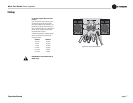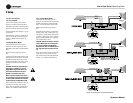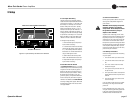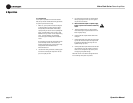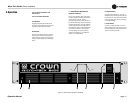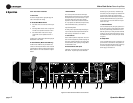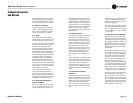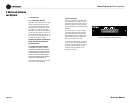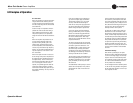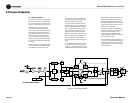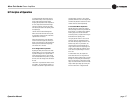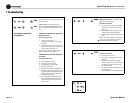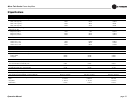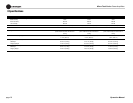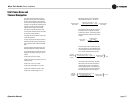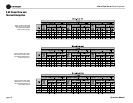
Micro-Tech Series Power Amplifiers
page 15
Operation Manual
6.1 Overview
Micro-Tech amplifiers incorporate several tech-
nological advancements including real-time
computer simulation of output transistor stress,
low-stress output stages and an advanced heat
sink embodiment.
Custom circuitry is incorporated to limit tem-
perature and current to safe levels making it
highly reliable and tolerant of faults. Unlike
many lesser amplifiers, it can operate at its
voltage and current limits without self-destruct-
ing.
Micro-Tech amplifiers are protected from all
common hazards that plague high-power
amplifiers including shorted, open or mis-
matched loads; overloaded power supplies;
excessive temperature, chain-destruction phe-
nomenon, input overload and high-frequency
blowups. The unit protects loudspeakers from
input and output DC, as well as turn-on and
turn-off transients.
Real-time computer simulation is used to cre-
ate an analogue of the junction temperature of
the output transistors (hereafter referred to as
the output devices). Current is limited only
when the device temperature becomes exces-
sive—and only by the minimum amount
required). This patented approach called Out-
put Device Emulation Protection (or ODEP)
maximizes the available output power and pro-
tects against overheating—the major cause of
device failure.
Crown also invented the four-quadrant topol-
ogy used in the output stages of each Micro-
Tech amplifier (see Figure 6.1). This special
circuitry is called the Grounded Bridge. It
makes full use of the power supply by deliver-
ing peak-to-peak voltages to the load that are
twice the voltage seen by the output devices.
As its name suggests, the Grounded Bridge
topology is referenced to ground. Composite
devices are constructed as gigantic NPN and
PNP devices to handle currents which exceed
the limits of available devices. Each output
stage has two composite NPN devices and two
composite PNP devices.
The devices connected to the load are referred
to as “high-side NPN and PNP” and the devices
connected to ground are referred to as “low-
side NPN and PNP.” Positive current is deliv-
ered to the load by increasing conductance
simultaneously in the high-side NPN and low-
side PNP stage, while decreasing conductance
of the high-side PNP and low-side NPN.
The two channels may be used together to dou-
ble the voltage (Bridge-Mono) or current (Par-
allel-Mono) presented to the load. This feature
gives you flexibility to maximize power avail-
able to the load.
A wide bandwidth, multiloop design is used for
state-of-the-art compensation. This produces
ideal behavior and results in ultra-low distor-
tion values.
Aluminum extrusions have been widely used
for heat sinks in power amplifiers due to their
low cost and reasonable performance. But mea-
sured on a watts per pound or watts per volume
basis, the extrusion technology doesn’t perform
nearly as well as the heat sink technology
developed for Micro-Tech amplifiers.
The heat sinks in a Micro-Tech amplifier are
fabricated from custom convoluted fin stock
that provides an extremely high ratio of area to
volume, or area to weight. All power devices are
mounted directly to massive heat spreaders that
are electrically at the Vcc potential. Making the
heat spreaders electrically alive improves ther-
mal performance by eliminating the insulating
interface underneath each power device. The
chassis itself is also used as part of the thermal
circuit to maximize utilization of the available
resources.
6.2 Circuit Theory
Each channel is powered by its own power
transformer T100 or T200. Both channels share
a common low-voltage supply. The secondary
output of T100 is full-wave rectified by D109
and is filtered by a large computer grade capac-
itor. A thermal switch embedded in the trans-
former protects it from overheating.
The low-voltage fanformer is rectified by diodes
D1, D2, D3 and D4 to generate an unregulated
24 volts. Monolithic regulators U1 and U2 pro-
vide a regulated ±15 volts.
6 Principles of Operation



